Nara, Japan’s ancient capital, offers a unique blend of natural splendor and cultural heritage that captivates visitors. From the towering bronze Buddha at Todaiji Temple to the serene deer roaming Nara Park, the city seamlessly merges its storied past with breathtaking landscapes. Delving into Nara’s rich history, travelers can enjoy the architectural marvels of historic temples, explore the imperial legacy at Heijo Palace, and discover the artistic treasures housed in the Nara National Museum. This enchanting fusion of nature and culture invites travelers to embark on a transformative journey through time and place, unveiling the enduring allure of Nara’s historical wonders.
Key Points
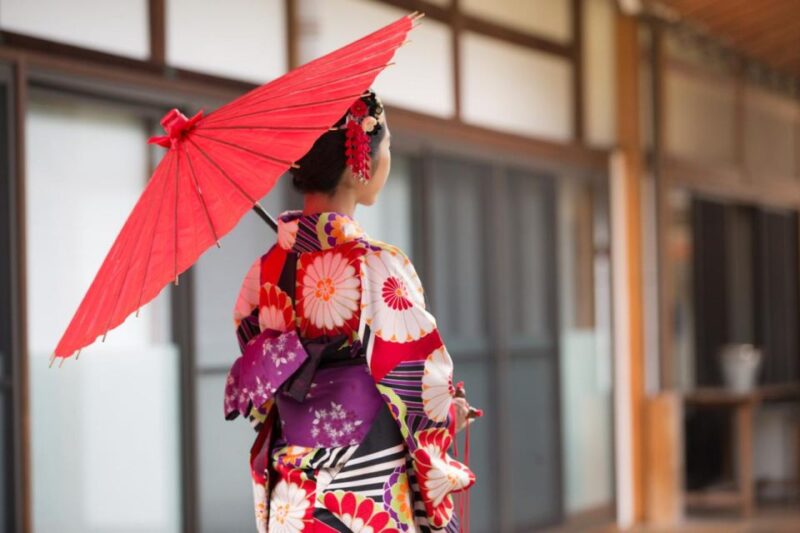
-
Explore the majestic Todai-ji Temple, home to the world’s largest bronze Buddha statue, and immerse in its serene grandeur.
-
Discover the natural harmony of Nara Park, where friendly deer roam freely amid historic shrines and temples steeped in Japanese tradition.
-
Explore Nara’s rich cultural heritage by visiting iconic temples like Horyu-ji, Kofuku-ji, and Yakushi-ji, each with its unique architectural and historical significance.
-
Uncover the grandeur of Nara’s imperial past at the Heijo Palace Site and the Nara National Museum, showcasing the region’s illustrious legacy.
-
Experience the tranquil beauty of Nara’s gardens, such as Isuien and Yoshikien, where the harmonious blend of nature and architecture offers a peaceful respite.
Todai-ji Temple’s Majestic Buddha
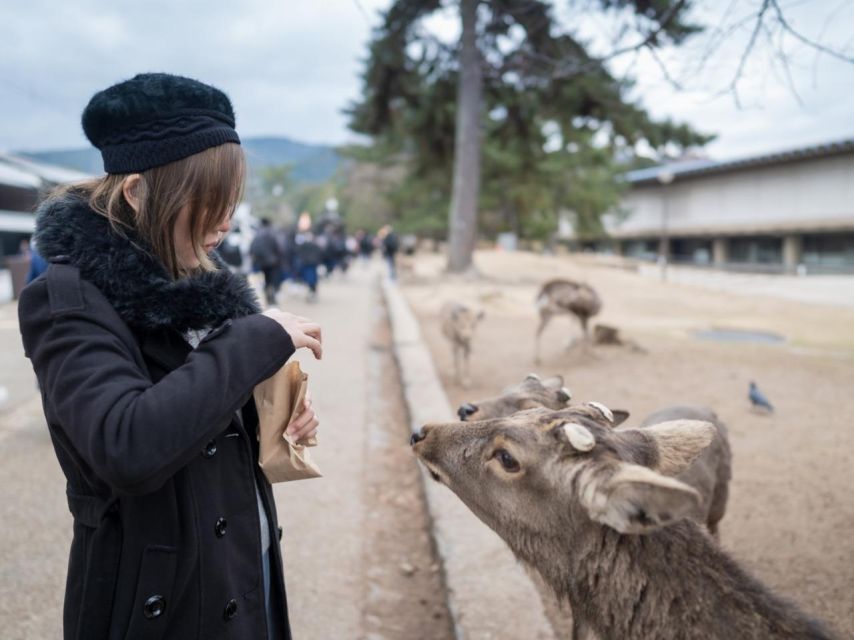
Towering within the grand confines of Todai-ji Temple, the world’s largest bronze Buddha statue commands reverence from all who gaze upon its majestic form.
Measuring an impressive 15 meters in height, the Daibutsu, as it’s affectionately known, is a breathtaking sight to behold. Visitors can marvel at the intricate details of the Buddha’s serene expression and the sheer scale of the colossal sculpture.
A guided tour provides deeper insight into the temple’s history and the significance of this iconic centerpiece.
Whether you’re a devout Buddhist or simply appreciative of exceptional craftsmanship, the Daibutsu at Todai-ji is a must-see attraction that will leave a lasting impression.
Fascinated by Nara's past? More historical tours we've covered
Nara Park’s Deer and Shrines

Nara Park, a lush green oasis, beckons visitors to explore its serene paths and encounter the friendly deer that roam freely throughout the grounds.
Alongside the park, the Kasuga Taisha Shrine stands as a revered Shinto site, its guided tour providing insight into the shrine’s significant history and cultural importance.
Towering over the park is Mount Wakakusa, offering a 20-minute hike to panoramic views of the surrounding landscape.
These natural and cultural wonders blend seamlessly, allowing visitors to enjoy Nara’s rich heritage while enjoying the tranquility of its verdant spaces.
Whether strolling through the park or discovering the shrine’s treasures, this captivating destination promises an unforgettable experience.
Historic Temples and Guided Tours
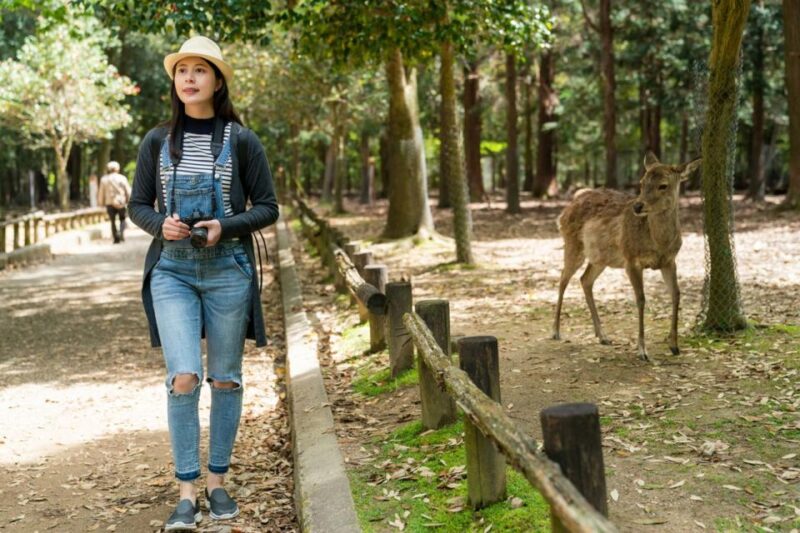
Alongside Nara Park’s serene natural wonders, the city’s historic temples offer visitors a glimpse into Japan’s rich cultural heritage, with guided tours providing a deeper understanding of these revered sites.
Travelers can explore iconic temples like Hōryū-ji, where they’ll marvel at ancient architecture and learn about the temple’s significant role in the spread of Buddhism.
At Kōfuku-ji and Yakushi-ji, guided visits uncover the temples’ intricate details and fascinating histories.
Shin-Yakushiji and Tōshōdai-ji further immerse visitors in Nara’s storied past, with knowledgeable guides shedding light on the temples’ unique features and significance.
These guided experiences allow travelers to fully appreciate the spiritual and historical importance of Nara’s remarkable temples.
Nara National Museum and Heijo Palace
The Nara National Museum houses an impressive collection that illuminates the region’s rich cultural and historical heritage, offering visitors a chance to delve deeper into Nara’s past.
Nearby, the Heijo Palace Site Historical Park provides a glimpse into the grandeur of Japan’s imperial legacy, with guided tours unveiling the architectural wonders and significance of this former seat of power.
At the museum, guests can explore artifacts, artworks, and interactive displays that chronicle Nara’s evolution, from its time as the nation’s capital to its enduring status as a cultural and spiritual hub.
The palace site, meanwhile, invites visitors to wander through the remnants of an imperial compound, imagining the pomp and circumstance that once graced these hallowed grounds.
More Great Thing To Do NearbyIsuien Garden and Neiraku Museum
Nestled in the heart of Nara’s historic district, the Isuien Garden and Neiraku Museum invite visitors to enjoy the tranquil beauty of traditional Japanese landscapes and uncover the region’s rich cultural treasures.
The 20-minute guided tour explores:
- Isuien Garden, a stunning example of Edo-period landscaping featuring serene ponds, carefully pruned trees, and stone bridges.
- Neiraku Museum, which showcases an impressive collection of Buddhist statues, ancient ceramics, and calligraphic masterpieces.
The harmonious blending of nature and architecture, offering a peaceful respite from the bustling city.
Insights into Nara’s long history as a center of cultural and artistic excellence.
Yoshikien Garden’s Tranquil Beauty
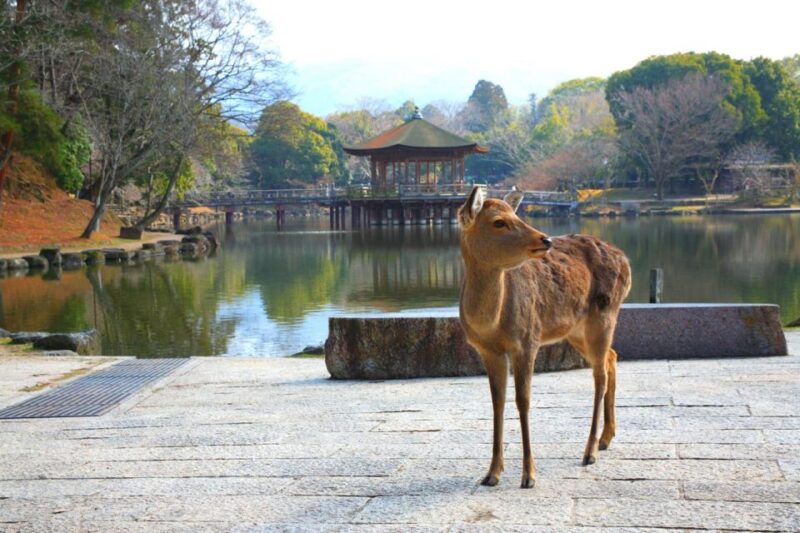
Tranquility pervades Yoshikien Garden, a verdant oasis amidst Nara’s historic charm. Visitors can enjoy a 20-minute guided tour that unveils the garden’s harmonious blend of landscape design and architectural elements.
Meandering paths lead past meticulously pruned trees, serene ponds, and stone bridges, creating a peaceful atmosphere. The garden’s highlight is the Shiguretei Teahouse, where guests can experience the refined Japanese tea ceremony.
As they sip matcha tea, they’ll appreciate the skillful integration of nature and traditional aesthetics. Yoshikien Garden offers a respite from the bustling city, inviting travelers to slow down and connect with the tranquil beauty that embodies the essence of Nara.
Exploring Nara’s Rich History
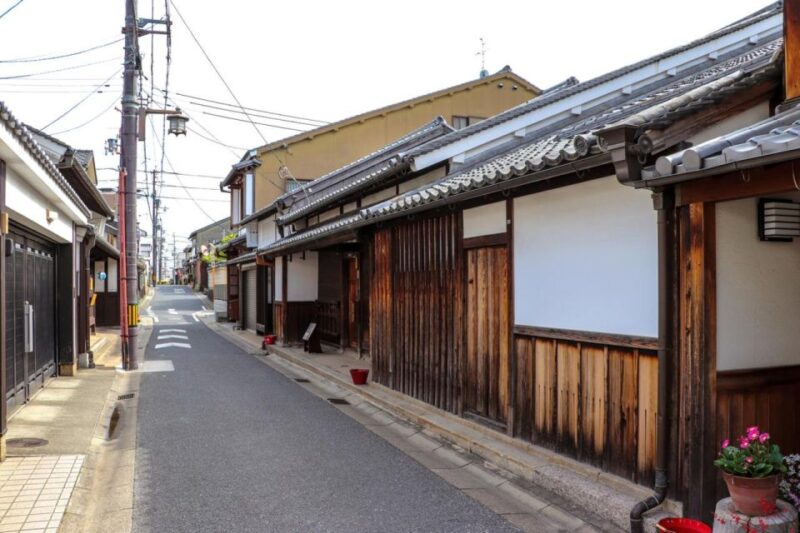
Centuries-old temples and historic sites dot Nara’s landscape, inviting visitors to enjoy the city’s captivating past. From the world’s largest bronze Buddha at Todai-ji Temple to the tranquil Kasuga Taisha Shrine, Nara’s rich history is on full display.
Explore the magnificent Horyu-ji Temple, one of the oldest wooden structures in the world, and learn about its storied past during a guided tour.
Discover the architectural marvels of Kofuku-ji and Yakushi-ji Temples, each with their own unique histories and cultural significance.
Uncover the secrets of the Heijo Palace Site, the former imperial capital, and gain insights into Nara’s illustrious legacy.
Explore the Nara National Museum’s impressive collection, where artifacts and exhibits shed light on the region’s remarkable heritage.
Nature and Culture Intertwined
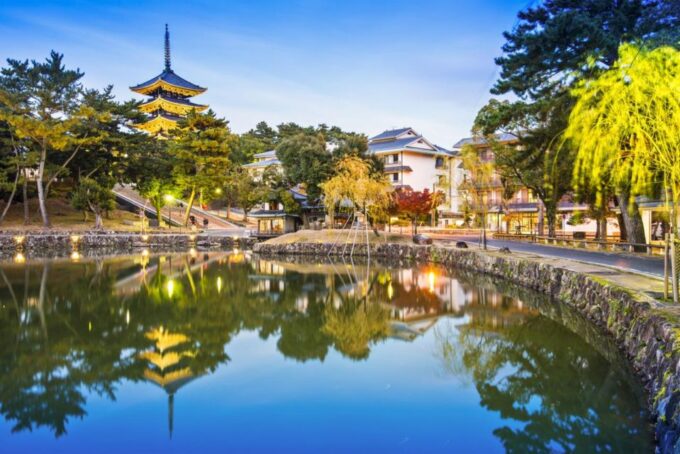
Nara’s verdant landscapes seamlessly intertwine with its rich cultural heritage, inviting visitors to experience the harmony between nature and history.
The lush Nara Park is home to friendly deer that roam freely, creating a captivating encounters for visitors. Towering over the park, the Todaiji Temple houses the world’s largest bronze Buddha, a testament to the region’s spiritual depth.
Nearby, the Kasuga Taisha Shrine, with its lantern-dotted paths, offers a glimpse into Nara’s enduring traditions. Beyond the parks, historic temples such as Horyu-ji and Kofuku-ji showcase the region’s architectural marvels, each with its own unique charm.
Nara’s natural beauty and cultural riches are inextricably linked, creating a truly immersive experience for all who venture here.
Frequently Asked Questions
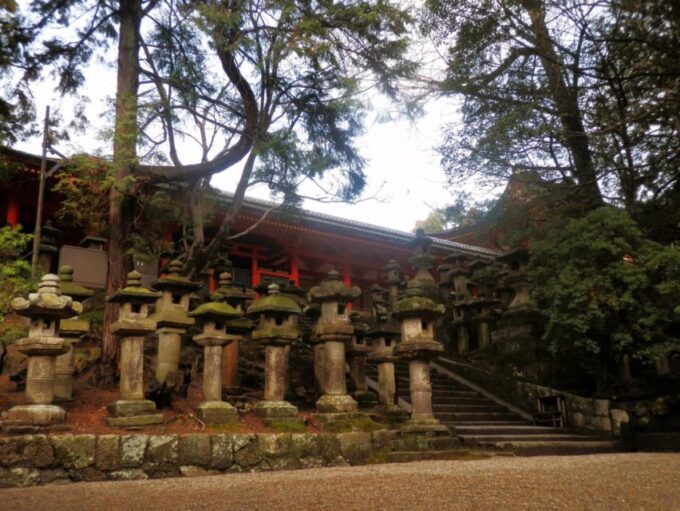
How Accessible Are the Temples and Shrines for Visitors With Disabilities?
Many of Nara’s historic temples and shrines offer wheelchair access and accommodations for visitors with disabilities. However, some sites have limited accessibility due to their age and traditional architecture. It’s best to inquire about specific accessibility needs before visiting.
Are There Any Dress Code Restrictions for Entering the Temples and Shrines?
Most temples and shrines in Nara have dress code requirements. Visitors are typically expected to wear modest, covered clothing. Shorts, short skirts, and sleeveless shirts may not be allowed. It’s best to check specific guidelines before visiting.
Can Visitors Take Photographs Inside the Temples and Shrines?
Visitors are generally allowed to take photographs inside the temples and shrines, but flash photography may be prohibited. It’s best to check with the temple or shrine staff before taking any photos.
What Are the Best Times to Visit Nara Park to Avoid Crowds?
The best times to visit Nara Park and avoid crowds are early morning and late afternoon. Crowds peak during the middle of the day, so visiting in the early or late hours provides a more peaceful experience.
Are There Any Special Events or Festivals Held in Nara Throughout the Year?
Nara hosts several festivals and events throughout the year. Key celebrations include the Nara Daibutsu-e in February, the Takayama Festival in April, and the Nara Lantern Festival in August. These events showcase the city’s rich cultural heritage and traditions.
Recap
Nara’s historical wonders seamlessly blend the city’s storied past and breathtaking natural landscapes.
Visitors can enjoy the architectural marvels of ancient temples, explore imperial legacies, and discover artistic treasures.
All of this is surrounded by the serene beauty of deer-roamed parks and meticulously-crafted gardens.
This captivating fusion of culture and nature offers a truly transformative journey through time and place.
You can check if your dates are available here:More Historical Tours in Nara
- Private 3-Hour UNESCO Heritage Sites & Deer Park Tour
- Nara: Bike Tour in Ancient Capital UNESCO World Heritage
- Nara: World Heritage Yakushi-ji & Toshodai-ji in 3 Hours
- World Heritage Kyoto & Nara Uji Authentic Matcha Experience
- Nara: World Heritage Gangoji Temple & Naramachi Old Town
- Nara: Kasuga Taisha, World Heritage and Sacred Deer Shrine
More Tour Reviews in Nara
- Private Nara Experience With Local Guide
- Taste of Nara A Guided Half Day Food Tour Tailored to Your Taste
- 7hr Private Guided Van Tour Nara & Matcha Farm
- Nara Private Custom Tour With Local Guide
- Nara: Half-Day Private Tour of 4 Must-See Spots & Deer Park
- Full Day Nara Deer, Temple, Shrine, Activities & Tea Ceremony
Not for you? Here's more things to do in Nara we have recnetly reviewed
- 5 Best Food Tours In Nara
- 4 Best Full-Day Tours In Nara
- 3 Best Private Car With Driver Services In Nara
- 3 Best Lunch Experiences In Nara
- From Osaka: Nara Private Customizable Day Tour
- Kyoto/Osaka: Nara Customizable Self-Guided Tour With Driver
- From Kobe: Nara Classic Private Tour With Car Pickup
- Nara: Visit a Tea Whisk Maker & Make Your Own Tea Whisk
- Nara: Visit a Tea Whisk Maker & Join the Unique Tea Ceremony
- Nara: Half-Day Private Tour of 4 Must-See Spots & Deer Park
- Nara: Customized Barhopping Tour – 3 Hours of Local Bars
- Nara: 1.5 Hour Private Kasuga Taisha Shrine Tour – World Heritage
